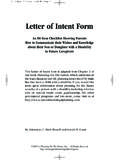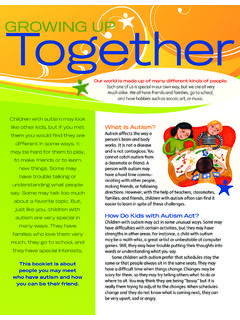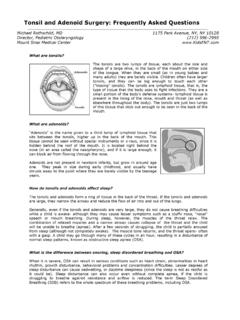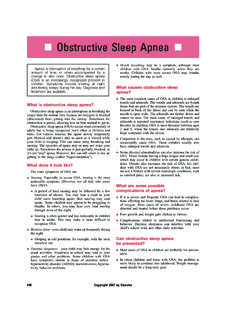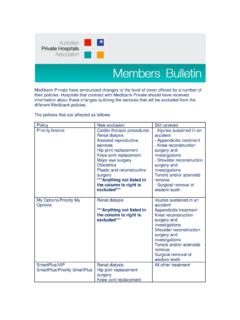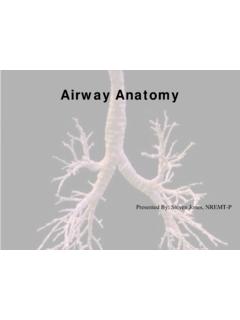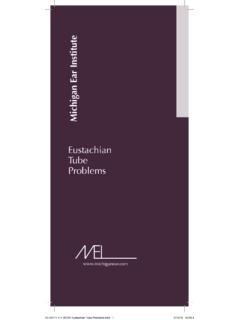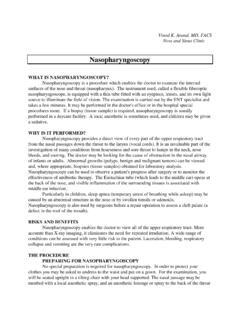Transcription of ACALCULIA: ACOUSTIC: ACTIVE LISTENING: ADENOIDS: …
1 1 ACALCULIA: Loss of ability in using mathematical symbols due to brain injury. ACOUSTIC: Pertaining to the perception of sound. ACTIVE LISTENING: Refers to the responsibility on the part of the listener to interact appropriately with the speaker and the speaker s message in order to maximize comprehension. Characteristics of the ACTIVE listener include attending to the speaker, focusing on the message, questioning self and speaker if appropriate, and analyzing and evaluating content to relate new information to prior knowledge and aid concept development. ADENOIDS: Growths of lymphoid tissue on the back wall of the throat (nasopharynx). AFFRICATE: A consonantal sound beginning as a stop (plosive) but expelled as a fricative. The ch and the j sounds in the words chain and jump are affricates. AGNOSIA: Loss of ability to interpret the meanings of sensory stimulation; due to brain injury; may be visual, auditory or tactual.
2 AIR WASTAGE: The use of silent exhalation before or after phonation on a single breath. ALLERGY: Extreme sensitivity to certain proteins. ALVEOLAR: The ridges on the jawbones beneath the gums. An alveolar sound is one in which the tongue makes contact with the upper-gum ridge. ANOXIA: Oxygen deficiency. ANTIEXPECTANCY: A group of devices used by the stutterer to distract himself from the expectation of stuttering. 2 APHASIA: The inability to acquire meaningful spoken language as a result of brain dysfunction. APHONIA: Loss of voice. APPROACH-AVOIDANCE: Refers to conflicts produced when the person is beset by two opposing drives to do or not to do something. APPROXIMATION: Behavior which comes closer to a standard or goal. APRAXIA: Loss of ability to make voluntary movements or to use tools meaningfully; due to brain injury. ARTICULATION: Refers to the production of sounds through the precise positioning and rapid movement of the various components of the oral cavity ( , tongue, lips, teeth, hard and soft palate) in relation to one another.
3 ASPIRATE: Breathy; the use of excessive initial airflow preceding phonation as in the aspirate attack. ASSIMILATION: A change in the characteristic of a speech sound due to the influence of adjacent sounds. In assimilation nasality, voiced sounds followed or preceded by a nasal consonant tend to be excessively nasalized. ASYMMETRY: Unequal proportionate size of the right and left halves of a structure. ATROPHY: A withering; a shrinking in size and decline in function of some bodily structure or organ. ATAXIA: Loss of ability to perform gross motor coordination. ATRESIA: The blockage of an opening or canal. ATTACK: The initiation of voicing. AUDIBLE: Refers to a sound which is capable of being heard. AUDITORY MEMORY SPAN: The ability to recall a series of test sounds, syllables, or words. AUDITORY SYSTEM: Refers to the outer, middle, and inner ear, as well as the neural pathway which conducts sound to the brain for perception and interpretation.
4 AURAL: Pertaining to hearing. AURICLE: The visible outer ear. AVOIDANCE: a device such as the use of a synonym or circumlocution to escape form having to speak a word upon which stuttering is a anticipated; also a trick to escape from having to speak in a feared situation. BABBLING: A continuous, free experimenting with speech sounds. BASAL FLUENCY LEVEL: The period of communication in which no stuttering appears. See Desensitization therapy. BASE-RATE: The presumably stable rate of responding to a stimulus or stimuli. 3 BICUSPID: The fourth and fifth teeth, each of which has two cusps or points. BIFID: Divided into two parts, as in a cleft or bifid uvula. BINAURAL: Pertaining to both ears. BONE CONDUCTION: The transmission of sound waves (speech) directly to the cochlea by means of the bones of the skull. BRADYLALIA: Abnormally slow utterance.
5 CATASTROPHIC RESPONSE: A sudden change in behavior by the aphasic characterized by extreme irritability, flushing or fainting, withdrawal or random movements. CLAVICULAR BREATHING: A form of shallow, gasping speech breathing in which the shoulder blades move with the short inhalations. CLUTTERING: A disorder of time or rhythm characterized by unorganized, hasty spurts of speech often accompanied by slurred articulation. COCHLEA: The spiral-shaped structure of the inner ear containing the end organs of the auditory nerve. COGNATE: Referring to pairs of sounds which are produced motorically in much the same way, one being voiced (sonant) and the other unvoiced (surd). Some cognants are t and d , s and z. COMMENTARY: The verbalization of what is being perceived as in self-talk or parallel talk. COMMUNICATION CYCLE: Refers to the relationship that exists between the four elements inherent in every act of communication ( , the sender, the receiver, the message and the vehicle used to convey the message).
6 COMMUNICATIVE INTENT: Refers to the purpose or function of a message ( , what the speaker means to indicate or accomplish through the message). COMPREHENSION: Refers to one s ability to understand speech and language in any form ( , oral, sign, written). CONDUCTIVE HEARING LOSS: Hearing loss due to failure of the bone levers in the middle ear to transmit sound vibrations to the cochlea. CONFIGURATIONS: (in articulation therapy) Patterning of sounds in proper sequence. CONTACT ULCERS: A breakdown in the tissues of the vocal cords, usually near their posterior attachments to the arytenoid cartilages. CONTENT WORDS: (Contentives) Words such as nouns and verbs that carry the major burden of meaningfulness. CONTINGENT: Following as a consequence of some preceding behavior. CONTINUANT: A speech sound which can be prolonged without distortion; , s or f or u.
7 4 COVERT: Hidden behavior; inner feelings, thoughts, reactions. CREATIVE DRAMATICS: An improvised, unrehearsed play acted spontaneously by a group of children with the unobtrusive aid of an adult leader. CV: A syllable containing the consonant-vowel sequence as in he or so or ha. CVC: A syllable containing the consonant-vowel-consonant sequence, as in the first syllable of the word containing (con). DECIBEL: A unit of sound intensity. DELAYED AUDITORY FEEDBACK: The return of one s own voice as an echo. DENTAL: Pertaining to teeth. A dentalized l sound is made with the tongue tip on the upper teeth. DEEP TESTING: The exploration of an articulation case s ability to articulate a large number of words, al of which include one specific sound, to discover those in which that sound is spoken correctly.
8 DESENSITIZATION: The toughening of a person to stress; increasing the person s ability to confront his problem with less anxiety, guilt, or hostility; a type of adaptation to stress therapy used for beginning stutterers. DIADOCHOKINESIS: The maximum speed of a rhythmically repeated movement. DIFFERENTIAL DIAGNOSIS: The process of distinguishing one disorder from another. DIFFERENTIATION: The functional separation of a finer movement from a larger one with which it formerly coexisted. DIPHTHONG: Two adjacent vowels within the same syllable which blend together. DISTORTION: The misarticulation of a standard sound in which the latter is replaced by a sound not normally used in a language. A lateral lisp is a distortion. DYSARTHRIA: Articulation disorders produced by peripheral or central nerve damage. DYFLUENCIES/DYSFLUENT SPEECH: Refers to a breakdown of the complex integration and timing of the patterns of respiration, phonation, and articulation, or a breakdown in the ability to automatically retrieve and sequence the words desired to convey a message.
9 DYSLALIA: Functional (nonorganic) disorders of articulation. DYSPHASIA: The general term for aphasic problems. DYSPHEMIA: A poorly timed control mechanism for coordinating sequential utterance. It is variously conceived as being due to a constitutional and hereditary difference or to psychopathology. It reflects itself in stuttering and cluttering. DYSPHONIAS: Disorders of voice. EAR TRAINING: Therapy devoted to self-hearing of speech deviations and standard utterance. 5 ECHOLALIA: The automatic involuntary repetition of heard phrases and sentences. ECHO SPEECH: A technique in which the case is trained to repeat instantly what he is hearing, following almost simultaneously the utterance of another person. Also called shadowing . EGO STRENGTH: Morale or self-confidence. ELECTROENCEPHALOGRAM ( ): The record of brain waves of electrical potential.
10 Used in diagnosing epilepsy, tumors, or other pathologies. EMBOLISM: A clogging of a blood vessel as by a clot. EPIGLOTTIS: The shield-like cartilage that hovers over the front part of the larynx. ESOPHAGEAL SPEECH: Speech of laryngectomized persons produced by air pulses ejected from the esophagus. ESOPHAGUS: The tube leading from the throat to the stomach. ETIOLOGY: Causation. EUNUCHOID VOICE: A very high pitched voice similar to that of a castrated male adult. EUSTACHIAN TUBE: The air canal connecting the throat cavity with the middle ear. EXPRESSIVE APHASIA: The difficulty in sending meaningful messages, as in the speaking, writing, or gesturing difficulties of the aphasic. Executive aphasia. FALSETTO: Usually the upper and unnatural range of a male voice produced by a different type of laryngeal functioning.
